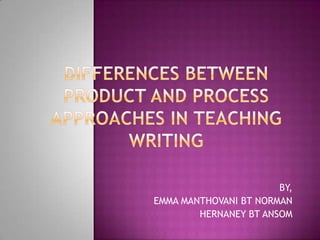
Differences between product and process approach
- 1. BY, EMMA MANTHOVANI BT NORMAN HERNANEY BT ANSOM
- 2. This is a traditional approach. Studentsare encouraged to mimic/imitate a model text. Usually presented and analysed at an early stage.
- 3. Organizationof ideas more important than the ideas itself. Student are required to produce a complete piece of writing straight away Emphasis on end product
- 4. Stage 1 Model texts are read, and then features of the genre are highlighted. Stage 2 This consists of controlled practice of the highlighted features, usually in isolation. Stage 3 Organisation of ideas. Stage 4 The end result of the learning process.
- 5. Focus more on the varied classroom activities which promote the development of language use: brainstorming, group discussion, re-writing. Can have any number of stages
- 6. Stage 1 Generating ideas by brainstorming and discussion. Stage 2 Students extend ideas into note form, and judge quality and usefulness of ideas. Stage 3 Students organise ideas into a mind map, spidergram, or linear form. Stage 4 Students write the first draft. This is done in class and frequently in pairs or groups. Stage 5 Drafts are exchanged, so that students become the readers of each other's work. Stage 6 Drafts are returned and improvements are made based upon peer feedback. Stage 7 A final draft is written. Stage 8 Students once again exchange and read each other's work and perhaps even write a response or reply.
- 7. Process writing Product writing text as a resource for imitate model text comparison organisation of ideas ideas as starting point more important than more than one draft ideas themselves more global, focus on one draft purpose, theme, text features highlighted type, i.e., reader is including controlled emphasised practice of those collaborative features individual
